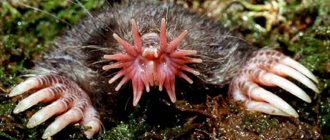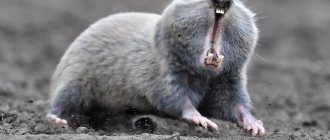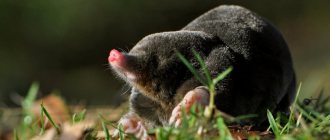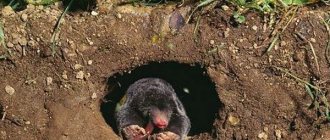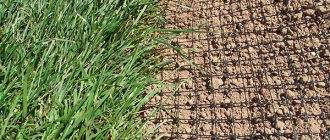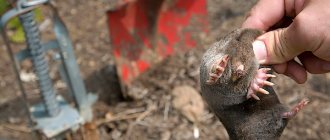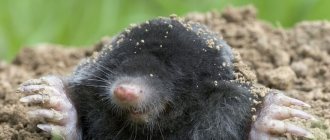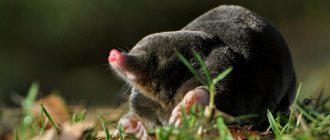Name: Common, South Russian and small-eyed mole rat Lat.:
Spalax microphthalmusClass: Mammals - Mammalia Order: Rodents - Rodentia Family: Mole rats - Spalacidae
| Habitats: | garden |
| Dangerous for: | roots, bulbs and rhizomes |
| Description: | A year-round active animal with a big appetite. |
Description and photo of the animal mole rat
Mole rat.
Mole rats are small animals of the rodent order. Their lifestyle is similar to moles, but outwardly they have significant differences.
Appearance of the animal
Adults can weigh up to 700 grams or more. The animal's body reaches 20-32 cm in length and has an oblong, cylindrical shape. The fur is thick, short, and colored pale gray-brown.
The neck is poorly defined. The legs are very short. The tail is not developed and is hidden under the skin. The head is the widest part of the animal's body and has a flattened shape. The animal has no ears, and its eyes are hidden under the skin. The incisors are pronounced and grow on top of the lips.
Have you seen a mole rat?
Not really
Lifestyle of mole rats
Mole rats on the surface of the earth are a rare occurrence.
The animals spend almost their entire lives underground. The burrow system of this animal is very well branched and has two tiers. The so-called “feeding passage” is the longest and is located at a depth of 20-25 cm. The mole rat’s home is equipped with summer and winter nests, as well as storage facilities for food supplies.
Unlike moles, mole rats make their way with the help of incisors. From the soil that the animal pushes out, characteristic mounds are formed - “mole rats”. The diameter of such “mole rats” can reach 50 cm. The total length of moves made by one rodent can be up to 450 m.
Mole rats do not hibernate in winter and therefore store large reserves of food. Winter supplies of one such rodent can weigh up to 14 kg.
What does the animal eat?
The diet of mole rats consists mainly of plant foods. The animal feeds on bulbs, tubers and rhizomes of various plants. Sometimes a rodent can feast on young stems and leaves, which it drags underground by grasping the rhizome.
Among the animal's winter supplies you can find acorns, onions, potatoes and beets.
Reproduction
An enemy in a fur coat.
Mole rats usually live in groups of 2-3 individuals, including one male and 1-2 females. If there is more than one female in a family, then they take turns producing offspring.
Cubs are born in the spring. Around this time, the male leaves the female who gave birth and goes to the one who will bear offspring next year.
One litter produces 2-3 cubs. Young females begin to move away from their mother already in the first year after birth. They settle mainly closer to the surface, so they often die before reaching two years of age. The mortality rate among young males is much lower, because they move away from their mother only in the second year and settle underground.
The average lifespan of mole rats in the wild is 2.5-4 years. Some specimens can live up to 9 years.
Litmus test
The common shrew is considered a pest because it eats the eggs of commercial fish. But when it began to disappear en masse in many areas of its former range, it was immediately forgotten. Just as biologists use mice to understand the level of pollution in forests and fields, so the shrew serves as a litmus test for the ecology of water bodies.
Anna Zvyagintseva, a resident of the Krasnogvardeisky district, described her uncle’s meeting with this animal:
“When he was sitting on the ice with a fishing rod, the cutter itself ran up to him and hid under his boot. He started filming it on his phone to show it to me. How interesting it was to watch her! She dived into a hole made for fishing and swam in the snow. And then the second one appeared. What they did together is beyond words! It turns out that the shrew, listed in the Red Book, lives on our Userdets River.”
After reading online sources, I learned that the Russian muskrat and the common shrew settle in oxbow lakes, small quiet backwaters, but always in ecologically clean rivers with forests along the banks. This means that the Userdets River is an environmentally friendly reservoir.”
Mole rat habitat
The habitat of mole rats includes steppe, forest-steppe, semi-deserts and deserts. Most often the animal is found in steppe and flat areas. Since mole rats feed mainly on plant foods, they happily settle in grassy meadows and clearings. In rare cases, mole rats can be found on the outskirts of forests.
When choosing soil, rodents prefer moderate density.
In clay and sandy soils, the mole rat most likely will not stay long.
The animals also do not particularly like salt marshes and wet areas.
Is the mole rat the same mole?
No, this is a wrong opinion. Animals are different, although they have a similar lifestyle.
Do mole rats bite?
Yes, and very much so. But he does not attack himself, but only in case of self-defense. His vision is not developed at all and in case of danger he attacks everyone and everything, relying only on hearing.
How likely is it to meet him?
Although the population is quite large, it is unlikely to encounter a mole rat. If it accidentally hits the surface, it freezes, listening and orienting itself, then backs away to get into its hole.
Mole lifestyle
Moles are considered uncooperative animals, so for a significant part of their entire lives they remain completely alone under the thickness of the earth. The only exception is the mating period of animals.
These diggers rarely change their usual habitats; most of their lives are spent in the same tunnel system that they once dug.
Moles are endowed with two glands that produce a musky-smelling secretion. With this smell they attract individuals of the opposite sex for mating, as well as worms, which form the basis of their food supply.
To survive, a mole needs to eat a number of worms and insects per day equal to half its weight. These diggers make such an extensive network of tunnels so that they contain more worms and insects that lead an underground lifestyle.
If the network of passages does not fully provide the mole with food, he begins to expand it to the required size.
The total length of underground passages can be several hundred meters. Moles constantly move along them in search of insects and worms, which turn out to be their easy prey. All underground communications formed by a mole can be divided into 2 types:
- Labyrinths of passages located near the surface of the earth. They act as traps for insects and worms, providing the mole with food. It is curious that without food, a mole cannot live more than 15 hours.
- The other type of passages are located much deeper. There, the animals arrange sleeping quarters for themselves and take shelter during the cold periods of the year. Since the animals need moisture, they dig passages from their sleeping quarters leading to water sources.
How to deal with a pest
The mole rat is a rodent whose habits are very similar to the mole. They are often even confused due to similar dietary preferences. The fight against mole rats is carried out using the same methods as with moles. For more information about them, follow the links below to the portal articles.
Plants are a safe way to protect your area from moles and other rodents.
Mole traps allow you to catch the pest quickly and easily.
The greenhouse requires protection from moles; they are comfortable there at any time.
Proven methods of controlling moles on the site. Fast and efficient.
Appearance of a mole
A mole is a small mammal that is part of the shrew order and the mole family. The body size of this animal can reach 20 cm. Behind the body there is a shortened tail.
The mole is equipped with four limbs. Its front legs are very different from its hind legs, they are more powerful and look like shoulder blades turned to the sides.
The paws have 5 toes ending in sharp claws. At the end of the phalanx the claws are forked. It is with them that the mole digs its underground passages. Because of such bizarre front paws, the animal looks unusual, which can be seen in the photo.
The mole's collarbones are made like a ridge and are quite well developed. The hind legs are elongated and resemble the legs of rats. The mole's tail is never long; its size can vary from 2 to 8 cm.
The head part of the animal's body is medium in size and has a conical shape. The nose is slightly elongated, and the ears are not visible at all. The sockets for the eyes are very small, and the eyes themselves lack a lens. The eyelids are very mobile. In some species, the eyes are covered with a thin skin. His vision is so poorly developed that he can be called blind. But moles have an excellent sense of smell, hearing and touch.
The mole's fur is usually black and evenly colored. However, there are species with brown or dark gray fur. The hair fibers grow in a strictly perpendicular direction from the skin. This allows the animal to quickly move underground in the usual way and backwards. Molting occurs in warm weather, three times within one year.
What does a mole's diet consist of?
The main mole food is earthworms. Worms, attracted by the smell of a special secretion secreted by moles, themselves penetrate into the labyrinths of the animal’s feeding passages. The mole is busy searching for food 24 hours a day throughout the year. The animal feeds 3 to 5 times a day, eating from 25 to 45 g of food per day.
Having had enough, the animal retires to the sleeping area and sleeps there for 3-5 hours, curled up in a ball. When sleep passes, the animal again rushes in search of food. If the mole finds more worms than he can eat, he deprives them of the head part and drags them into special storage rooms. He starts eating them when he wakes up again.
It is curious that moles do not eat food of plant origin. Plant fibers can sometimes enter the animal’s stomach completely by accident, for example, when eating worms that had fibers in their stomach. The mole body is not able to digest plant fibers; they leave the body undigested.
When food becomes insufficient, the mole begins to dig new tunnels, expanding its hunting territory. If the usual food becomes insufficient, moles begin to eat frogs, small vertebrates and even rats.
The animal spends a lot of energy digging tunnels. To restore the balance of energy, the mole needs to eat a lot. On some days, a mole can eat a mass of food that exceeds its weight.
This animal has a very good metabolism; it can digest 50 g of food within 35 minutes, despite the fact that only 20 grams fit in its stomach. 4 hours after eating, the mole feels hungry again.
Moles also constantly need water for drinking. Therefore, they equip their passage system not far from water sources.
Reproduction
Sometimes moles break their solitary lifestyle to mate. Immediately after its completion, the male leaves the female. He does not help build nests for his young and does not participate in their upbringing. During the breeding season, females show increased aggressiveness towards individuals of their own sex.
Usually there is no more than one brood per year. The gestation period varies depending on the species from 30 (common moles) to 42 days (Eastern moles).
A new generation is born in nests. A brood consists of two to seven individuals. Initially they are naked and hairless, but after two weeks they become overgrown with fur. At three weeks of age, their eyes open. In the first month, babies' nutrition consists only of mother's milk. On the 35th day, moles leave their native nest and begin to look for a free area for themselves. During this period, many of them die under the wheels of cars or from predators.
When and how often do moles molt?
Moles, compared to other animals, molt not twice a year, but three or even four times. This need arises due to the fact that when the mole continuously moves through underground passages, its fur quickly wears out.
As a result, it turns out that the mole sheds throughout the warm period of the year. In places where molting has already occurred, the animal’s skin becomes darker and 3 times thicker. However, hair on such areas of the skin does not adhere well and wears out quickly.
Moles molt for the first time from April to June. In females, molting begins a little earlier than in males. Instead of worn-out winter fur, moles receive less warm spring skin.
At the zenith of July, adults molt again. In the same month, the young animals molt for the first time.
As soon as the summer molt ends, only a week passes and the autumn molt of animals begins. When it is completed, the mole appears in his most attractive form. The autumn fur of moles is the warmest and most elegant. It is thick, tall, velvety, black with a silvery tint.
Economic importance of moles
During the Soviet Union, people highly valued mole fur. The beautiful velvety skins of the animal are very durable; they were used for sewing fur coats. Such fur coats were not the warmest, but they were in fashion and cost a lot of money.
In the middle of the last century, mole fishing in the USSR was in full swing. Animal skins were harvested in significant quantities throughout the country, especially in the Urals and central Russia.
Nowadays, the fashion for mole fur coats has gone, and along with it, such a craft has lost its significance. In some regions of Russia, moles continue to be caught and their skins are used for making clothes. But the volume of such catching is quite insignificant.
Places where moles live
Moles like to inhabit the following places:
- meadows;
- forest clearings;
- birch forests and copses;
- areas near roads;
- parks within the city;
- garden and vegetable plots.
Molehills are often found where the soil is enriched with humus, populated by worms, arthropod larvae, and heated by the sun. Soil moisture is also of great importance; it should have average values.
Traces of moles are unlikely to be found in the following places:
- dense forest;
- Pinery;
- swampy places;
- places where plants with strong roots grow.
The mole’s choice of place to live also depends on the annual amount of precipitation and soil temperature. If the climate in the area is not stable, moles move closer to the forest, where the depth of soil freezing in winter is less, and in summer moisture in the soil is better retained.
The mole will constantly change its location until it finds comfortable living conditions for itself.
Appearance description
The behavior and appearance of the mole have not been studied in as much detail as we would like. The fact is that the mammal chooses hard-to-reach places to live. But still, biologists were able to track this animal in the wild.
It is in appearance that the relative nature of the mole’s adaptability to life underground is revealed. The animal has strong front legs, which allow it to constantly dig the ground. The rounded hands resemble oars in appearance, and the wide palms are turned outward. The fingers are spread apart and end in long, strong claws.
The hind legs are not so strong; with them the mole only scrapes loose soil out of the hole. A long muzzle with an elongated nose helps the animal find food and safe places by smell. The body is covered with a short fur coat, which does not interfere with movement through narrow underground passages.
The wool grows upward and can bend in any direction. The common mole is black-brown or dark gray in color. The mammal has eyes, but they only distinguish between light and darkness. The animals are practically blind, although they do not need vision underground. The structure of the eyeball of moles differs from the organs of other animals . They do not have a lens or retina . Movable eyelids and thick fur protect the eyes from soil getting into them. Mammals have a well-developed sense of smell.
